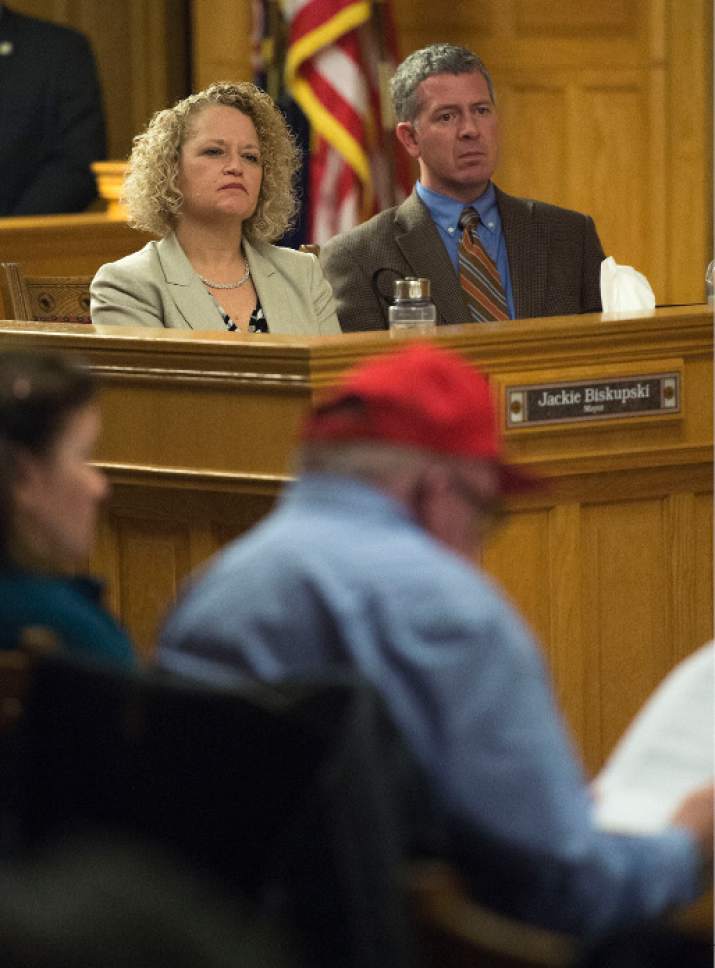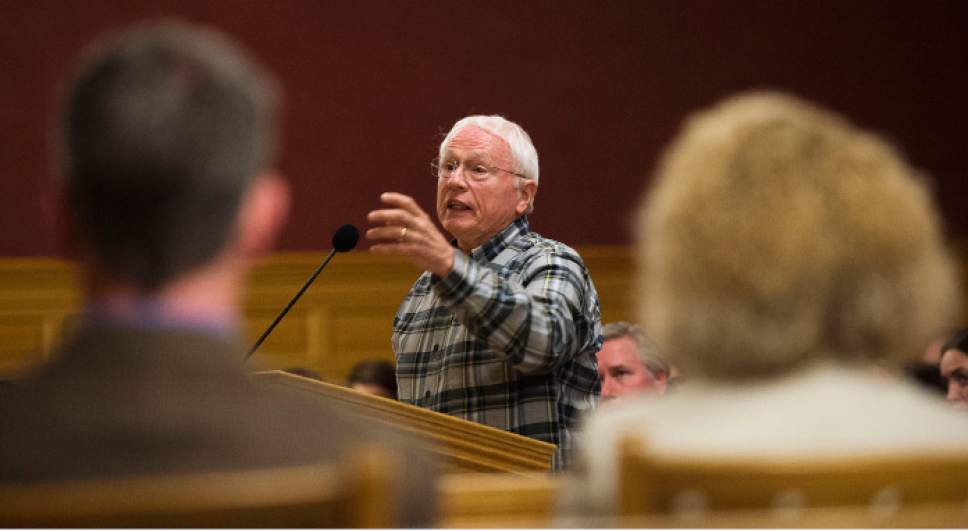This is an archived article that was published on sltrib.com in 2017, and information in the article may be outdated. It is provided only for personal research purposes and may not be reprinted.
Salt Lake City Mayor Jackie Biskupski said after a packed City Council meeting Tuesday night that it is still possible for the city to reverse siting decisions for four 150-bed homeless shelters, even if the properties have already been purchased.
"But at this point," she said," we have not changed our mind."
The Salt Lake City Council didn't vote on a nonbinding resolution in support of four new homeless shelters Tuesday night, but the council and Biskupski got an earful from affected residents anyway.
About 100 people packed the council chambers while 50 waited their turn in an overflow room across the hall.
A few directed their pleas at Biskupski, who chose to attend and heard more than two hours of complaints from constituents, even though the city had previously characterized its decision as final.
A common thread was that few felt they were involved in the process, and that despite the city's descriptions of self-contained, one-stop resource centers, many envision the drugs and violence associated with the downtown Rio Grande emergency shelter.
Some used their two minutes to relate a perceived loss of security and home value. Some said they owned businesses near a site.
"To be frank, we feel like the wool was very much pulled over our eyes during this entire process," said Tess Arneson, who owns 9th and 9th Pilates and said she'd broken ground on a development two blocks from a site at 131 E. 700 South.
Two tenants have since pulled out, she said.
Paul Atkinson said he's lived in four houses on Simpson Avenue and currently resides right across the street from the site at 653 E. Simpson. A neighbor just put his house up for sale, he said. Jeremy Brown said he lives a block away and returned from military service in Afghanistan to be "blindsided."
"I'm just really upset about not having a say, not having a voice, and the things that I fought for being trampled upon," Brown said. He, too, said he's listed his house, though he's holding out to see if the city will undo the selection.
A majority said they lived near 653 E. Simpson, which abuts a neighborhood and is the farthest east of the four chosen sites (275 W. High Ave. and 648 W. 100 South are the others).
Councilwoman Erin Mendenhall, whose district is a few blocks away from Simpson, previously said she would have voted against what was an effectively ceremonial resolution to support the city's choice.
"That ended the solidarity, and that shattered the point" of the resolution, said council member Lisa Adams, whose district includes Simpson Ave.
The council decided not to vote at a Dec. 13 meeting because Biskupski was called away on a family emergency. Adams would have voted against the resolution too, the councilwoman said.
"I think that resolution is still on the table," Biskupski said. "I've been gone, and so that's been part of the problem, with getting it back out there, but I think, no matter what, when it's all done and whether we do Simpson or don't do Simpson or we have a new site or we don't have a new site, we will all sign a joint resolution."
Purchase of property is the domain of the city's administration, and council members say that while their support for the four sites was sought, it wasn't necessary.
Those decisions were made behind closed doors, in accordance with Utah's public meetings law, to protect the city's bargaining power.
Biskupski reiterated that she also hoped to avoid pitting neighborhood against neighborhood, and said when she left Tuesday's meeting, "People were telling me which neighborhood they should be in."
None of them, she said, suggested Sugar House.
Should the sites be "rethought," Biskupski said, "that would be a joint effort between the council and I, and I think the information gathering and the information sharing needs to continue for the next while."
Many residents said they learned about the locations from news reports. Patrick Thomas, who lives across the street from 653 E. Simpson, said he found out from a newscaster who thrust a mic in his face.
After earlier appearing for more than an hour at the council's work session, Salt Lake County Mayor Ben McAdams told media he, too, would liked to have seen more public input on the shelter sites.
"You just don't know what you don't know until you've solicited public input," McAdams said, adding that the sites all work from the county's perspective as the standard-bearer on programming and services.
But the county's Collective Impact didn't escape Tuesday's public comment unscathed, either.
Some speakers said they doubted whether a scattered-site model was truly an improvement, and if services will reduce the population to a point where it an be served by 500 fewer beds than the 1,100-capacity downtown shelter, The Road Home.
Biskupski said the heated response to sites has been fed by misinformation.
"We need to be better at working in tandem with the county to explain the new model and the service model that's coming," she said.
Bob Barr said he owns two properties but that their proximity to the planned 150-bed shelters won't affect his business, as other speakers feared, or his safety, as a 6-foot-5, 250-pound man.
Said Barr: "What I am worried about is how a group of people could spend the millions of dollars you've spent to acquire properties, and yet I have not heard yet one dime spent for resources, consultation — anything that would tell me you have the vaguest idea what you're doing."
Adams spoke earlier Tuesday to a small group of Sugar House citizens who — unknown to her — had planned to protest during the work session. They decided instead to speak during the allotted time during the public comment session.
The input session ended with an earlier speaker being escorted from the chamber after addressing Councilman Derek Kitchen out of turn and refusing to be quiet.
City officials plan to appear at three community council meetings on Wednesday and Thursday nights, and three community workshops they say will influence the design of the sites will be held Jan. 11 and Jan. 18.
To much less fuss, the council voted unanimously in a straw poll to make Stan Penfold its 2017 chairman after he served as vice chairman in 2016.
Charlie Luke was named 2017 vice chairman.
Penfold nominated and voted for Mendenhall, but the other five council members chose Luke.
Twitter: @matthew_piper









